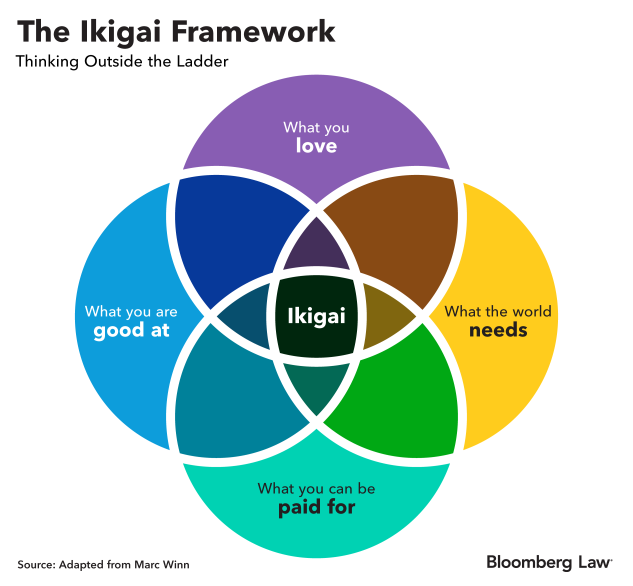Rob Chesnut, former general counsel and Justice Department prosecutor, writes on in-house, corporate, and legal ethics issues. He explores the Japanese concept of ikigai as a framework for career and performance discussions.
It’s getting near year end, and if you’re like a lot of managers, you’ve been putting off the awkward 1:1 career and performance discussion with your direct reports. You know, the one where you ask them what they see themselves doing in five years, and they respond by telling you that they want YOUR job. After a week, you feel like there are buzzards circling around your desk, waiting for you to retire. Here are a few suggestions to make the career talk less awkward, and more useful.
The Ikigai Framework
First, put forward a structure that your whole department can use that creates a framework for authentic, human conversation. I used to get “outside the box” and “inside the spinning circles” of a Japanese concept known as ikigai. Ikigai refers to finding your purpose in life. If you aren’t familiar with ikigai, I’ve included a visual of it below that I used in talking career and life with everyone on my team at Airbnb.
It centers on understanding four things about each person, represented by the four circles below. I usually start by talking with the person about what they’re good at, and make a point to explore areas that I may not have seen and may not be evident in the individual’s current role. It’s a good two-way conversation, where I’m often able to chime in with things I perceive as strengths that the individual may not have thought about.
I then move to “what you love,” and again, I try to push boundaries and get away from just talking about the law—do they like music, or gardening, or sports. Understanding the “whole person” is critical to having a career discussion that’s really meaningful. From there, we move clockwise to “what the world needs” and “what you can get paid for,” with a focus on areas that might be related to topics that came up in the first two circles.
After filling in the circles, it’s interesting to have the person plot their career in the diagram, starting with their first job out of school, to the present day. Ideally, I’d want everyone on my team to be on a journey that moves them closer to the center of the four circles—at a place where they’re doing work they love that takes advantage of their skill set, that serves a real purpose in the world, and that pays them well.
If they aren’t happy with the direction their career is headed, ikigai is a useful framework to help both of you identify where things are off. The interesting thing about ikigai is that it’s dynamic. No one stays in the same place, as their skill set grows and financial needs change, and what they used to love becomes stale. The circles themselves are spinning too, as the world evolves and needs different things—think AI—requiring skill sets to evolve.
Think Outside the Ladder
With ikigai as the framework, it’s important to help people “think outside the ladder.” Careers don’t always move up, they can take crazy turns as interesting opportunities present themselves. I moved from being a civil constitutional lawyer, to a federal espionage prosecutor, to an in-house tech attorney, swinging over to running a business unit before moving back to the law world as a general counsel. Now, I’m an author and adviser to companies.
I’ve seen so many good lawyers with the right skill sets move from a legal role to a business role, or move to another country within a global company to fulfill a dream to live and raise a family abroad.
These things are only possible if you really understand and appreciate the whole employee. Armed with a good ikigai framework, you can champion your attorney for a key business role when the right opportunity arises. Great leaders don’t hoard talent—they develop it and then help the employee move to other areas within the company where they can be a key ally to the legal department.
I also think it’s important to “think outside your own company.” I often told attorneys on my team that I would help them grow their careers within the company, but in some circumstances I’ve candidly admitted that their career aspirations and the company’s needs might not be aligned long term. I make it clear that I love them and want them to stay, and that they’ll be top of mind for the right opportunities inside the company. But I also offer to help them find that dream role somewhere else, if that’s what they really want to do.
I point out that aspirations can be achieved through volunteer work, or side advisory roles. I offer suggestions and even make introductions within my network that might help them achieve their goal. Yes, I might lose a good employee. But employees rarely spend their entire career at the same company anyway, and I’ve found that employees really respect that you sincerely want to help them in their career, even if it’s somewhere else.
Try these different approaches the next time you set up those career discussion meetings. You might find that helping your team members find their purpose in life through work becomes one of your favorite parts of leading a team.
Rob Chesnut consults on legal and ethical issues and was formerly general counsel and chief ethics officer at Airbnb. He spent more than a decade as a Justice Department prosecutor.
To contact the editors responsible for this story:


